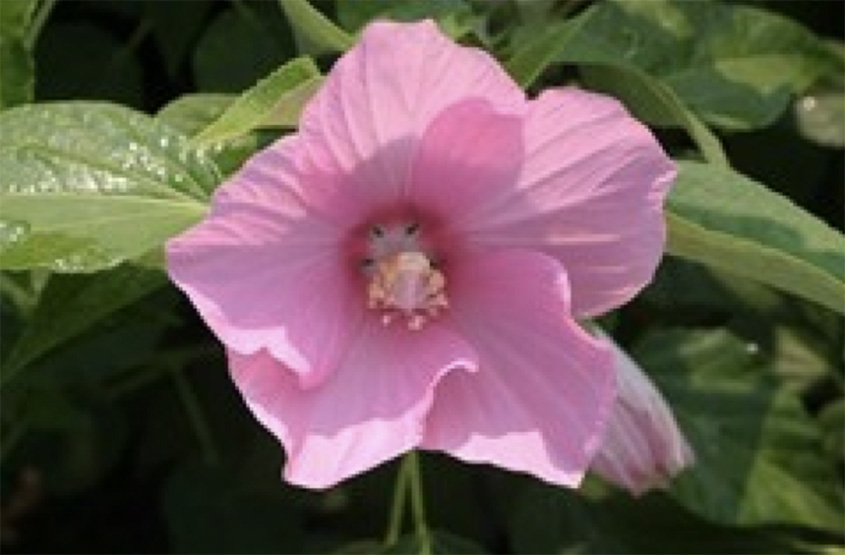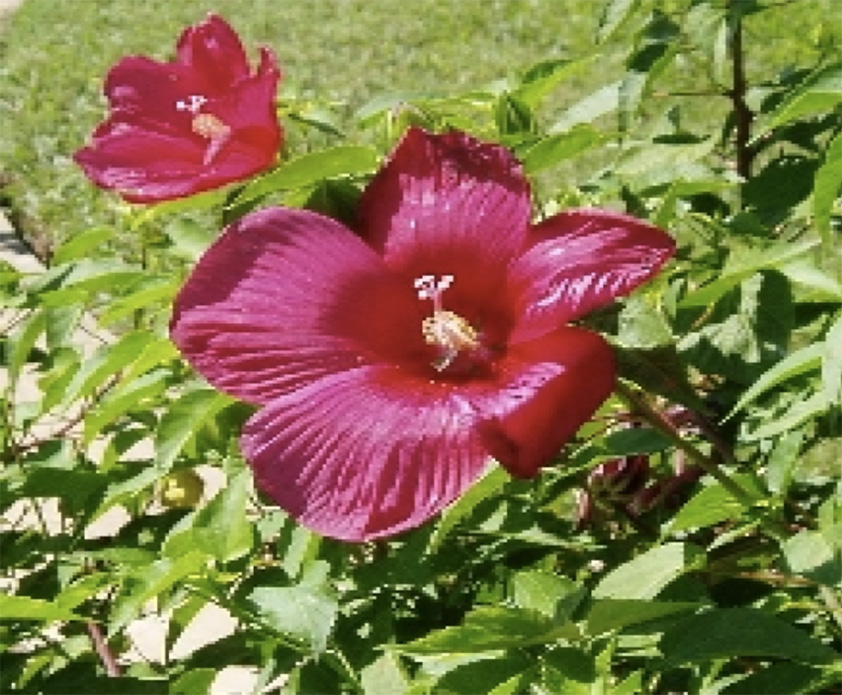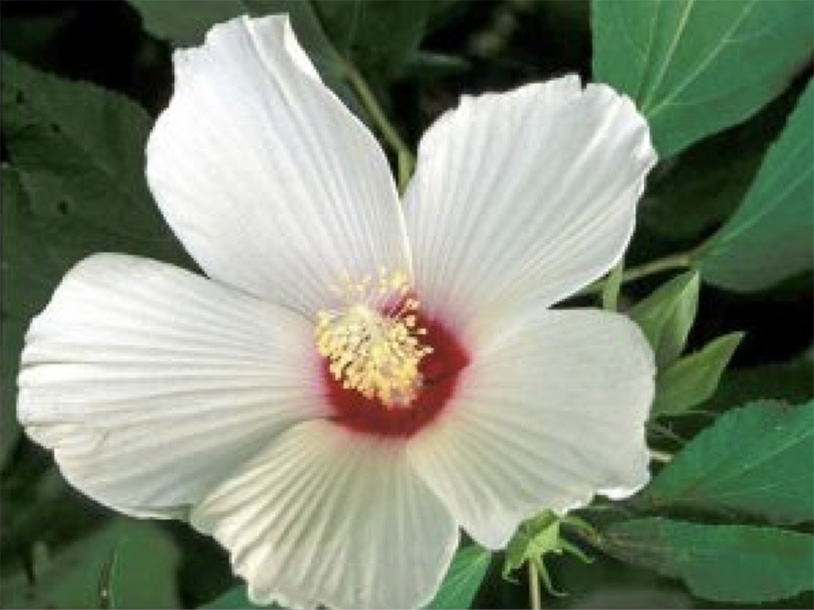Swamp Rose Mallow
Hibiscus moscheutos, also commonly known as swamp rose mallow, is a beautiful perennial plant with attractive pink or white flowers that bloom from July to September. It is native from southern to eastern North America.
Scientific Name: Hibiscus moscheutos L.
Common Name: Rose mallow, swamp rose mallow, crimson-eyed rose mallow, eastern rose mallow, marshmallow
hibiscus
Plant Family: Malvaceae (Mallow Family)
Etymology: Hibiscus moscheutos derives from the Greek word hibiskos which is associated with marsh mellow or mallow-like plant. Moscheutos means musk-scented in Latin.
Indigenous Uses
The only known usage of swamp rose mallow by indigenous tribes is from the Shinnecock tribe located on what is now Long Island, New York. This tribe utilized the plant for medicinal purposes specifically relating to the treatment of bladder infections. They would infuse dried swamp rose mallow stems for infections as well as for a urinary aid. However, many settlers used swamp rose mallow for their ability to relieve inflammation and irritation externally.
Edible Parts
The leaf buds and young leaves of the swamp rose mallow can be consumed as well as the flowers. The leaf buds can be cooked or eaten raw. The young leaves have a mild taste with a gelatinous consistency that can be added to salads. The flowers can be eaten cooked or raw and also have a mild taste and gelatinous consistency. The root of the plant can also be eaten but is quite tough. Although each of these portions can be consumed, they do not have much flavor and can be used more for presentation aspects of a dish and to add texture. The seeds can be roasted and are high in protein and starch.
Gathering and Using
The seeds of the swamp rose mallow can be collected when they turn a dark brown coloration which occurs typically 4-5 weeks after flowering. The seeds can then be roasted and are a good source of starch and protein. Seeds can also be ground and used as a coffee substitute, although they do not contain caffeine. The leaves of the plant can be infused by adding them to boiling water that can help relieve coughs and sore throats. The leaves and roots also contain abundant amounts of mucilage and can be used to treat dysentery, lung ailments, and urinary infections. The infusion of the dried stalks has been used to treat bladder infections. A tea made out of the boiled leaves can also be used to treat digestive inflammations as well. The flowers have been used externally to reduce the swelling and pain of bruises and bee or wasp stings.
Permaculture Functions and Considerations
Medicinal uses, aesthetic, moist borders, temporary screen when in bloom, attracts pollinators, immunity to humidity and heat, flower gardens, wildlife support, deer resistant.
Habitat
The swamp rose mallow is grown in conditions that have moist to wet soil and primarily full sun. It is not affected by humidity and heat, so it is able to grow in these conditions particularly found in the deep south of the U.S. They are primarily found in areas that have swampy forests, wet meadows, or freshwater marshes from the southern to eastern portions of North America. They are also effective along streams and ponds.
How to Identify
The swamp rose mallow grows between 3 to 7 ft with a spread of 2 to 4 ft. The leaves of the plant are dark green on the top and white with hairs on the bottom, growing up to 8 inches. The leaves are oval or lanceolate shaped with slightly toothed edges and are lobe less or shallow lobed. The flowers of the plant bloom from July to September and can grow from 6 to 8 inches in diameter. The flowers are large and bell-shaped with five overlapping petals and a white or pink coloration. The inner portion of the flower is a dark crimson color with a staminal column protruding from the center. The staminal column has white anthers that surround a long style. After flowering, dark brown, kidney-shaped seeds are produced. The stems of the plant are rounded and green with tiny white hairs and a broad base.
 Missouri Botanical Garden, Accessed March 5th, 2022
Missouri Botanical Garden, Accessed March 5th, 2022
 Buckallew, Robin R. Accessed March 5, 2022
Buckallew, Robin R. Accessed March 5, 2022
 Hamilton, Helen. Accessed March 5th, 2022
Hamilton, Helen. Accessed March 5th, 2022
Wildlife Support
The swamp rose mallow is an important wildlife support plant particularly for pollinators and bird species. The nectar of the mallow is a source for species of butterflies such as the Eastern Tiger Swallowtail that accesses the nectar through slits at the base of the flower. It is also attractive to pollinators due to the beauty and coloration of the flower. The Rose Mallow Bee only collects pollen from the swamp rose mallow and morning glories. The leaves and flowers of the plant also benefit caterpillars of multiple butterflies such as the Gray Hairstreak, Common Checkered-Skipper, and Painted Lady. The seeds of the plant are consumed by birds in the fall and winter such as Wood Ducks. The plants also have been known to serve as nesting sites for the Red Winged Blackbird. The Ruby-Throated Hummingbird also utilizes the flower for nectar. The plant has also been known to be deer resistant due to its mild taste.
Additional Information
In Hindu mythology, the red hibiscus is the flower of the goddess Kali and represents primordial energy and empowerment. It was also believed to increase mortals' ability to connect on a conscious level to the divine. In Egyptian and Greek mythology, the flower is associated with romance and lust.
Sources
- Austin, Daniel F., & Honychurch, P. N. (2004). Hibiscus. In Florida ethnobotany. essay, CRC Press.
- Borge, Mary A. The Natural Web. “Swamp Rose Mallow – for Bees, Butterflies, Beetles, Birds, and Beauty.” TheNaturalWeb.org, August 2016.
- Stanton, Kristen M. “Hibiscus Flower Meanings & Symbolism + Hibiscus Planting, Care & Uses.” UniGuide.com, December 2021.
- TWC Staff. Lady Bird Johnson Wildflower Center. University of Texas Austin. “Hibiscus Moscheutos” org, October 2019.
- Vorderbruggen, Mark M. Foraging Texas. “Mallow-Rose.” ForagingTexas.com, August 2008.